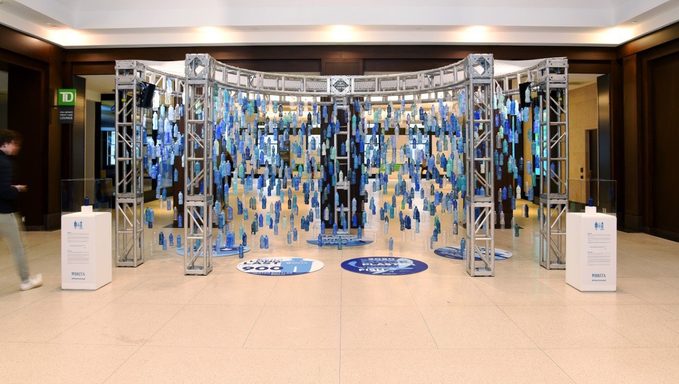Torontonians Discard This Staggering Number of Plastic Bottles Every Five Minutes
A new art installation in Toronto’s Union Station wants to draw attention to Canada’s single-use water bottle problem.

Just this week, a pregnant sperm whale made headlines when it was found dead off the coast of Sardinia with 48 pounds of plastic in its stomach.
In the same news cycle, New York became the second state to approve a statewide ban on single-use plastic bags. Plastic straws are on the way out, too.
The world has finally started to realize its global plastics problem, and now an art installation in Toronto’s Union Station hopes to show Canadians the tangible effects of their actions on Canada’s waterways—and one thing they can do to help.
Artist Asher Jay, known for her exhibits made from single-use plastic water bottles, has partnered with Brita Canada to create Niagara Now, a 12-foot-high waterfall with painted water bottles hung by fishing line. Jay and her team salvaged 900 bottles for the display—the same number that is consumed and discarded in Toronto every five minutes.
“Bottled water has become so cheap, so ubiquitous,” says Matt Kohler, VP Marketing for Brita Canada. “I think consumers have this perception that plastic bottles aren’t a problem because they’re recyclable. But the reality is, most of that stuff doesn’t end up recycled. It ends up in a landfill or in our waterways. In Canada, we consume two billion water bottles per year, which is 5.3 million a day. About 22 million pounds of plastic makes its way into the Great Lakes every year. It’s a crazy statistic.”
Though Niagara Now is not Asher Jay’s first time working with plastic bottles, it’s the first time she’s showcased the single-use plastics problem alongside one possible solution: the Brita Longlast™ filter, which can purify 900 single-use bottles worth of water. “Often, we spiral into despair and hopelessness and don’t know what to do,” she says. “This exhibit is a great way to tell people, ‘Hey, this is something you can do next.’”
And with the image of cascading water, Jay hopes that people will realize the great impact that we can all have together. “It’s not about one person changing one thing,” she says. “It’s about the cumulative effect of everyone making a better choice.”
Niagara Now will be on display on the ground floor of Union Station until April 6, 2019.
Next, check out more facts that will make you stop using plastic.




